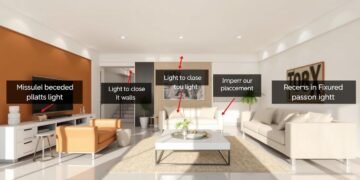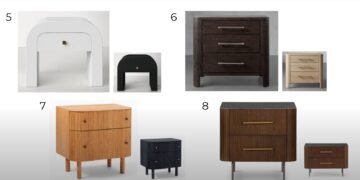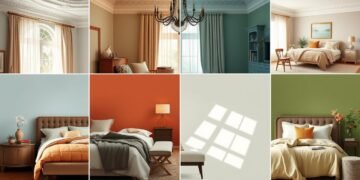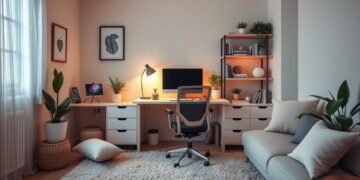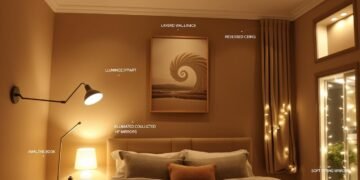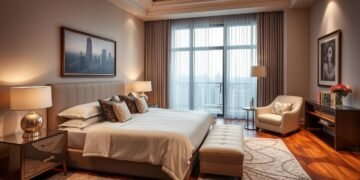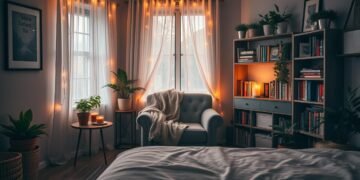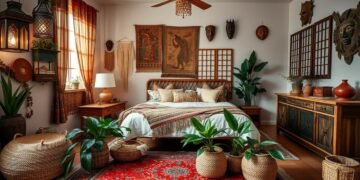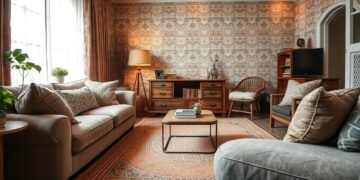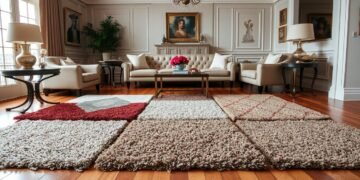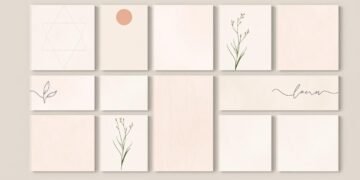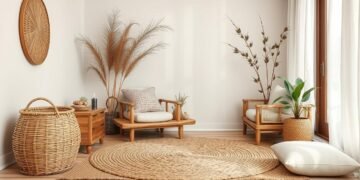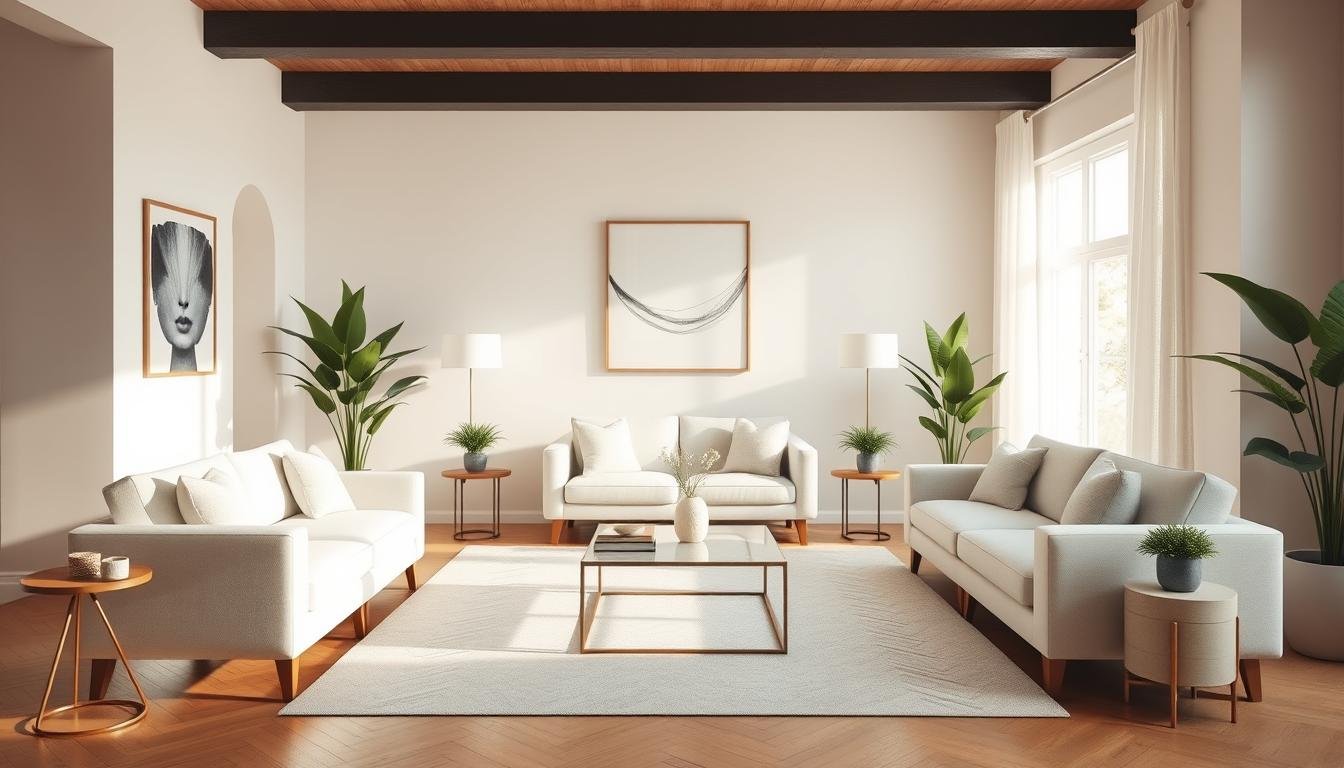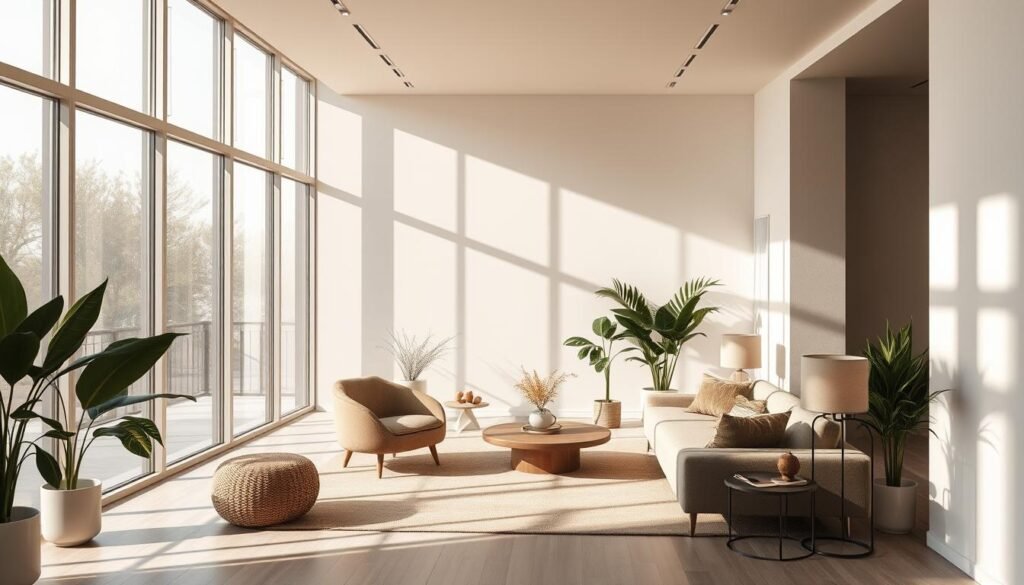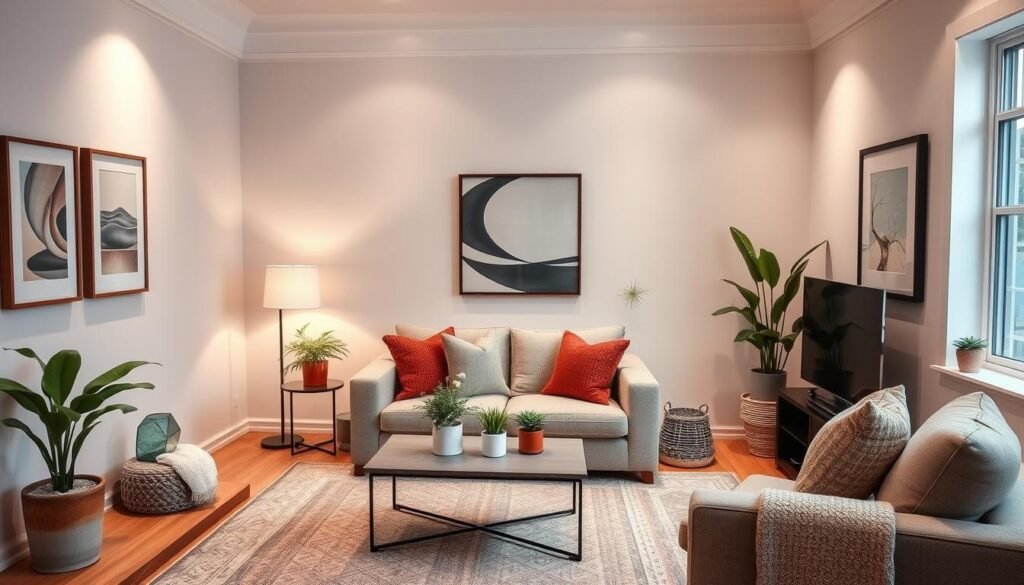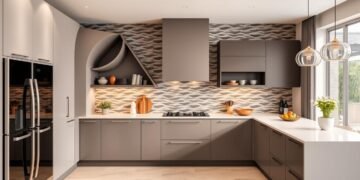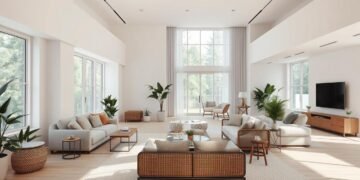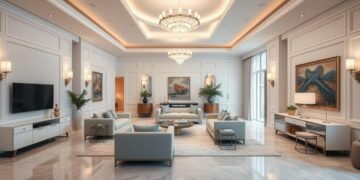Imagine a calm living room where everything fits perfectly together. This is what balance in interior design is all about. It’s about making sure everything looks good and feels right1. Interior designer Phillip Thomas says balance is personal, but the rules stay the same1.
There are two main ways to achieve balance: symmetrical and asymmetrical designs. Symmetrical designs are neat and formal. Asymmetrical designs are more relaxed and unique1. The trick is to pick what works best for your space and style, making sure everything feels balanced and welcoming.
Table of Contents
- 1 Understanding Balance in Interior Design
- 1.1 What Creates Visual Balance
- 1.2 Types of Balance in Design
- 1.3 Relatedarticles
- 1.4 8 Clever Ways to Introduce Rhythm and Movement into Your Décor
- 1.5 The 6 Simple Steps to Create a Harmonious Interior That Flows
- 1.6 5 Proven Tips for Getting Proportion Right in Every Room
- 1.7 The Psychology of Balanced Spaces
- 2 Mastering Symmetrical Design Elements
- 3 The Art of Color Distribution using the 60-30-10 Rule
- 4 Creating Visual Weight Through Furniture Placement
- 5 Incorporating Multiple Levels for Dynamic Balance
- 6 Using Light and Shadow to Enhance Balance
- 7 Balancing Textures and Materials
- 8 Achieving Balance in Small Spaces
- 9 Radial Balance: Creating Focal Points
- 10 Conclusion
- 11 FAQ
- 11.1 What is the importance of balance in interior design?
- 11.2 What are the different types of balance in interior design?
- 11.3 How does the psychology of balanced spaces affect the overall feel of a room?
- 11.4 What is the 60-30-10 rule for color balance in interior design?
- 11.5 How does furniture placement affect the balance in a room?
- 11.6 What design elements can be used to create different levels and distribute visual weight in a room?
- 11.7 How can lighting and shadows influence the balance in a room?
- 11.8 What role do textures and materials play in creating balance in a room?
- 11.9 How can balance be achieved in small spaces?
- 11.10 What is radial balance in interior design, and how can it be implemented?
Key Takeaways
- Balance in interior design is subjective and can vary for each project.
- Symmetrical balance creates a formal, ordered look, while asymmetrical balance offers a more eclectic and casual feel.
- Achieving balance involves distributing visual weight and creating a sense of equilibrium in the space.
- The 60-30-10 color rule is a helpful guideline for balanced color schemes.
- Contrast, scale, and proportion are essential elements in creating a balanced interior design.
Understanding Balance in Interior Design
Creating visual balance is key in interior design. It makes a space look good and feel right. This balance comes from how we arrange things, like using symmetry, asymmetry, or radial designs2.
What Creates Visual Balance
Symmetrical balance makes a space calm by placing things evenly. Asymmetrical balance adds depth and interest with its unique arrangement2. Using odd numbers in design also makes things more interesting2.
Types of Balance in Design
There are three main types of balance: symmetrical, asymmetrical, and radial. Symmetrical design, based on the Golden Ratio, is calming3. Asymmetrical design is more dynamic and informal3. Radial design, with elements spreading out from a center, is great for hotels and offices3.
The Psychology of Balanced Spaces
Good interior design affects how we feel in a space. Symmetrical design brings stability and order4. Asymmetrical design adds tension and surprise, making a space more lively4. Negative space, or empty areas, helps balance busy spots and keeps things interesting4.
| Type of Balance | Characteristics | Psychological Impact |
|---|---|---|
| Symmetrical | Even distribution of design elements, based on the Golden Ratio | Calming, harmonious, and stable |
| Asymmetrical | Dynamic arrangement of design elements, creating visual interest | Tension, surprise, and engagement |
| Radial | Centered focal point with design elements radiating outward or inward | Sociable, intimate, and suitable for dining and seating areas |
“Achieving balance in interior design is not just about symmetry, but the thoughtful arrangement of elements to create a visually compelling and psychologically comforting space.”
Mastering Symmetrical Design Elements
Symmetry is a powerful tool for creating balance and harmony in interior design. By arranging furnishings and decor elements in a symmetrical manner, you can establish a sense of order and cohesion. This makes a space feel neat, organized, and visually pleasing5.
One common way to achieve symmetrical balance is by mirroring the placement of sofas, armchairs, tables, and lamps around a central focal point. This could be a coffee table or fireplace. This approach creates a unified and elegant design that feels crisp and clean5.
- Symmetrical balance often involves arranging elements evenly on either side of a central axis, creating a mirror image effect5.
- Asymmetrical balance, on the other hand, relies on placing elements of different sizes, shapes, and colors in a visually appealing manner without being identical5.
- Radial balance involves arranging elements around a central point, extending outwards in all directions, commonly seen in circular setups or creating focal points5.
When mastering symmetrical design, it’s also important to consider the principles of proportion and human scale. Ensuring that the size and scale of furniture, decor, and architectural features are in harmony with the space can greatly enhance the overall balance and visual appeal of a room5.
| Design Principle | Explanation |
|---|---|
| Proportion | The relationship between size, scale, and dimension in a space, ensuring visual harmony between furniture, decor, and architectural features5. |
| Human Scale | Objects, furniture, and spaces are proportioned to fit the average human body, making the space more comfortable and usable5. |
| Visual Weight | Determined by factors like size, color, texture, and placement of objects, influencing the perceived presence of an item in a space5. |
By mastering the principles of symmetrical design, you can create a harmonious and visually balanced interior. This invites calm and serenity. Remember, the key to achieving perfect balance lies in the careful consideration of proportions, scale, and the strategic placement of furnishings and decor elements5.
The Art of Color Distribution using the 60-30-10 Rule
Creating perfect color balance in your home is an art. The 60-30-10 rule is a well-known guide for this6. It says 60% of a room should be one color, 30% another, and 10% an accent6. This rule helps make a room look good and feel right.
Primary Color Selection
The main color, making up 60% of the room, is key6. It could be the walls, big furniture, or a large rug. Pick a color that matches the mood you want in the room. Neutral colors like white, gray, or beige are good choices because they go with many things7.
Secondary Color Implementation
The secondary color, taking up 30% of the room, should match the main color but add depth6. It can be in textiles, furniture, or decorations. Use this color less than the main one to keep things balanced6. You can use color wheel schemes to pick your secondary color7.
Accent Color Placement
The last 10% is for accent colors, which can be bold or subtle6. These can be throw pillows, art, or small decorations. Picking an accent color that contrasts or matches the main and secondary colors makes the room pop7. You can adjust the 60-30-10 rule to fit your taste, like 40-30-20-10 or 50-25-15-1067.
Learning the 60-30-10 rule can make your home look and feel better67. The secret is to try different things, have fun, and show your style.
Creating Visual Weight Through Furniture Placement
Furniture arrangement is key to balancing your home decor. The visual weight of each piece, like sofas and wallpapers, must be balanced with harmonious items89. Evenly spreading visual weight, including the ceiling, makes your design intentional and eye-catching.
To prevent “dead spaces” or “ghostly dance floors,” arrange seating wisely. Use pedestals and art to add reflective spaces8. This makes every corner of the room feel purposeful and engaging, creating a harmonious atmosphere.
In furniture balance and room size, bigger rooms can handle more decor without feeling crowded. Smaller spaces need a careful approach to visual weight distribution in interior layouts8. Understanding furniture arrangement for balanced flow helps create a space that’s balanced, harmonious, and visually captivating.
“Achieving perfect balance with visual weight requires considering what is missing in the space, not just what is present.”
Whether it’s a cozy nook or a grand living room, mastering furniture balance for a harmonious space is essential. Thoughtful arrangement and visual weight distribution can take your home decor to new levels of beauty and function89.
Incorporating Multiple Levels for Dynamic Balance
Creating different levels in a room can make it more interesting and balanced10. You can use furniture, lighting, and accessories of different sizes and heights. For example, a tall floor lamp next to a sofa adds vertical interest and balance10.
Styling shelves with objects of different sizes can make a room more engaging10. Using furniture of various heights can turn a flat space into a balanced and interesting place10.
Height Variations in Furniture
Make sure your furniture fits well with the room’s size11. Mixing tall and short pieces, like a high chair with a low coffee table, adds balance and interest12. Try layering different heights to create a look that shows off your style.
Vertical Design Elements
Use wall art, shelving, and lighting to add height and interest12. Arranging pieces at different levels draws the eye up, adding depth and balance10. Hanging wall art in a staggered or asymmetrical way can make the room more interesting and balanced.
Layering Techniques
Layering can add depth and balance to your design12. Try overlapping rugs, placing furniture at different distances from walls, and arranging décor in a pleasing way11. This method prevents a flat look and brings harmony to the space.
By using multiple levels and heights, you can create a dynamic and balanced interior10. Remember, balance is not just about symmetry. It’s about making a space that feels cohesive and reflects your style.
Using Light and Shadow to Enhance Balance
Getting the right lighting balance is key for beautiful interiors. Good lighting can make any room feel more welcoming and stylish. By mixing ambient, task, and accent lighting, you can set a mood and add luxury13.
Ambient lighting, like ceiling lamps, lights up the whole room. Task lighting, such as desk lamps, helps with specific tasks. Accent lighting, like spotlights, brings out design details and adds flair13.
Natural light is also vital for balance in rooms13. South-facing windows are great for bright areas like kitchens. North-facing windows offer softer light, perfect for bedrooms13.
Using mirrors, light walls, and clear materials can improve natural light. This creates a balanced and welcoming atmosphere13.
Shadows are important for balancing light and shadow in interiors14. North-facing rooms get cool, dim light, while south-facing ones get warm, bright light14. Using dimmers, accent walls, and mixing warm and cool light can balance light and shadow1314.
Mastering lighting balance lets you create stunning, harmonious spaces. These spaces show off your style and make your home more functional1314.
Balancing Textures and Materials
Mixing different textures and materials is key to a balanced, luxurious home. By mixing soft and hard surfaces, you get a design that’s both captivating and harmonious15. Adding plush fabrics to sleek metal or glass brings depth and interest.
Using natural elements like wood, stone, or plants is also important. Plus, textiles strategically used in pillows, rugs, and throws can make a space pop15. These items help focus the eye and make a room look better16. Designers say it’s vital to spread out heavier textures evenly for balance.
Choosing the right textiles is critical. Consider updating window treatments for better texture balance16. A grand dining area example shows how carefully chosen colors and textures can create a seamless look16. Designers tailor their choices to fit each space’s unique character.
16 A study shows a balanced color scheme in a luxurious living room can feel sophisticated16. It’s wise to invest in premium textures and colors for lasting beauty16. Designers suggest flexible designs that can evolve with changing tastes and trends.
“Mixing different textures is a powerful way to create visual interest and depth in a space. It’s all about finding the right balance between soft and hard, smooth and rough, natural and synthetic.”
– Interior Design Expert
Achieving Balance in Small Spaces
To balance small spaces, think about scale and proportion. Use furniture that does more than one thing17. Place mirrors to make rooms look bigger and brighter18.
Light colors make spaces feel larger and more open18. Use tall bookcases or curtains to make rooms feel deeper18. Furniture with open legs adds to the openness18.
Keep your space clean to make it feel bigger18.
| Product | Description | Key Feature |
|---|---|---|
| Plinth Low by Menu | A meticulously assembled side table made in a small-sized factory in Portugal | Consistent quality and shape17 |
| Dauville Gold Glazed Bowl by Canvas Home | A unique artisan-influenced bowl with irregular metallic glazing | Artisan influence and irregular metallic glazing17 |
| Georg Stool by Skagerak | A light FSC-certified Oak stool with a braided leather strap and woolen cushion | Sustainable materials and functional design17 |
“Achieving balance in small spaces is about creating a cohesive and visually appealing environment that maximizes functionality without compromising the overall design aesthetic.”
Radial Balance: Creating Focal Points
In interior design, balance is key to making a space look good and feel comfortable19. Radial balance is a favorite for big homes or those with curved walls. It makes the layout look nice and balanced19.
Radial balance uses a central point and circular shapes to fill the space20. It creates a balanced look and a focal point that catches the eye20. Symmetry is important here because it makes us feel good mentally21.
To use radial balance well, place design elements around the main point20. A big chandelier or pendant light can be the center. Then, add circular things like rugs, mirrors, or art to spread out from it20. Even if things look a bit off, they can feel balanced if they’re placed right21.
Circles make a space feel calm and welcoming20. Radial balance helps define areas in open spaces, like a dining area. It makes the space look nice and inviting21.
The secret to radial balance is placing things right around the center19. This way, everything looks good together19. With this skill, you can make your space stand out and feel amazing19.
Conclusion
Getting balance in home interiors is a journey that needs focus and care. It’s about paying attention to color distribution, furniture placement, lighting, textures, and materials. Even though rules like the 60-30-10 rule for color balance exist, every home is different. So, you might need to tailor your approach22.
Balance can be found in symmetry, asymmetry, or a mix of both23. It’s smart to check your space at different times and seasons to adjust the balance. With time and effort, you can make harmonious, functional, and visually appealing living spaces. These spaces will show off your style and make your life better23.
Learning how to achieve balance in home interiors helps you create functional and balanced spaces. These spaces can make you feel calm and happy. Designing for balanced living spaces is a journey, but the benefits of a balanced home are worth it24.







